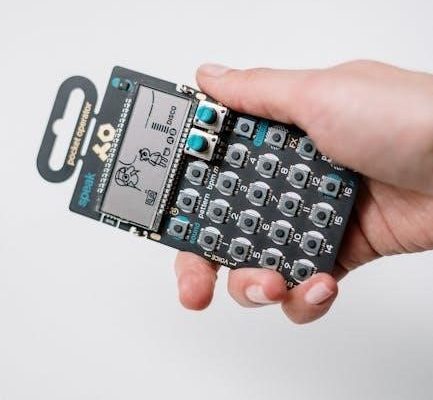What is a Combo Heat Press?
A combo heat press is a versatile machine combining multiple heat transfer functions. It allows applying designs to various items efficiently.
What is a Combo Heat Press?
A combo heat press is a versatile machine designed to perform various heat transfer applications. Unlike single-purpose heat presses, a combo unit typically includes interchangeable attachments, allowing users to transfer designs onto a wide range of items, such as t-shirts, mugs, plates, caps, and more. This adaptability makes combo heat presses ideal for businesses or individuals who need to handle diverse customization projects. These machines often feature a flat platen for fabrics and other flat surfaces, along with attachments for curved or uniquely shaped items. By offering multiple functionalities in one device, combo heat presses provide a cost-effective and space-saving solution for heat transfer needs, catering to diverse creative and commercial applications. They are a great investment for any professional!
Understanding the Machine’s Components
The heating element and platen are crucial. The element heats the platen, which then presses onto the item, transferring the design.
Heating Element and Platen
The heating element is the heart of the combo heat press, responsible for generating the necessary heat for transfer. It’s typically a metal plate with embedded heating coils. The platen, usually made of aluminum, distributes the heat evenly across the surface. Proper heat distribution is vital for consistent transfer results. Inspect the platen regularly for scratches or damage, as these can affect heat distribution and transfer quality. Ensure the heating element is securely attached to the platen to prevent uneven heating. The temperature of the heating element is controlled by the machine’s thermostat and timer, allowing for precise adjustments based on the material being used. Different materials require different temperatures and pressing times for optimal results. Always consult the manufacturer’s recommendations for specific materials. The platen should be clean and free of any residue to ensure proper adhesion of the transfer material. Use a non-abrasive cleaner to avoid damaging the platen’s surface. Regularly check the heating element for signs of wear or damage, such as discoloration or uneven heating. If any issues are detected, replace the heating element promptly to prevent further damage or inconsistent transfers. The size and shape of the platen will determine the maximum size and shape of the items that can be transferred. Choose a combo heat press with a platen size that meets your specific needs. Some combo heat presses come with interchangeable platens, allowing for greater versatility in terms of item size and shape. These interchangeable platens can be easily swapped out to accommodate different projects, making the combo heat press a versatile tool for various applications. Proper maintenance and care of the heating element and platen will ensure consistent and reliable performance for years to come.
Pressure Adjustment Mechanism
The pressure adjustment mechanism controls the force applied during the heat transfer process. It’s crucial for achieving optimal results and preventing damage to materials. Most combo heat presses use a knob or lever to adjust the pressure. Proper pressure ensures the transfer adheres correctly and evenly to the substrate. Too little pressure can result in a weak transfer, while too much pressure can distort or damage the item. The pressure adjustment mechanism should be easy to operate and provide a wide range of pressure settings. This allows you to fine-tune the pressure for different materials and transfer types. Regularly check the pressure adjustment mechanism for smooth operation and proper calibration. A poorly calibrated mechanism can lead to inconsistent results and wasted materials. Some combo heat presses feature a digital pressure display, providing precise and repeatable pressure settings. This is particularly useful for high-volume production or when working with delicate materials. The pressure adjustment mechanism should be durable and able to withstand repeated use without losing its accuracy. A sturdy mechanism will ensure consistent pressure over time, leading to reliable transfer results. When adjusting the pressure, always start with a low setting and gradually increase it until you achieve the desired result. This will help prevent over-pressing and damage to the item. Consider the thickness and type of material when determining the appropriate pressure setting; Thicker materials may require more pressure than thinner materials. The pressure adjustment mechanism is a critical component of the combo heat press, and proper use is essential for achieving professional-quality transfers. Always refer to the manufacturer’s recommendations for pressure settings for specific materials and transfer types.
Initial Setup and Calibration
Ensure the heat press is connected to a suitable power outlet. Verify voltage and amperage requirements before plugging it in to prevent damage.
Connecting to Power Supply
Before initiating the connection to the power supply, meticulously inspect the power cable for any signs of damage, such as fraying or exposed wires. A compromised power cable poses a significant safety hazard and must be replaced immediately to prevent electrical shock or fire. Ensure that the power outlet you intend to use is properly grounded and capable of handling the electrical load of the heat press. Consult the machine’s specifications to verify the voltage and amperage requirements, and confirm that the outlet matches these specifications. Using an incompatible power source can damage the heat press and void the warranty. Once you’ve confirmed the power outlet’s suitability, securely plug the power cable into the outlet. Avoid using extension cords or power strips unless absolutely necessary, as these can introduce additional points of failure. If an extension cord is unavoidable, ensure it is heavy-duty and rated to handle the heat press’s power requirements. After plugging in the power cable, double-check that the connection is firm and that the cable is not strained or stretched. A loose connection can cause overheating and potentially lead to a fire. Finally, before turning on the heat press, familiarize yourself with the location of the power switch and the emergency shut-off switch, in case of any unforeseen circumstances.
Setting Temperature and Timer
Accurately setting the temperature and timer on your combo heat press is paramount for successful and consistent transfers. Begin by consulting the transfer material’s instructions for the recommended temperature and dwell time. These settings can vary significantly depending on the type of material, such as vinyl, sublimation paper, or heat transfer paper. Refer to the manufacturer’s guidelines for the specific product you are using to avoid under or over-pressing, which can result in poor adhesion, scorching, or color distortion. Once you have determined the correct settings, use the control panel on your heat press to input the desired temperature. Most heat presses allow you to set the temperature in either Celsius or Fahrenheit. Ensure that you select the correct unit of measurement to avoid errors. After setting the temperature, input the recommended dwell time. The dwell time is the amount of time the heat press will apply pressure to the material. Accurate timing is critical for achieving optimal results. If your heat press has a digital timer, set it to the precise number of seconds recommended by the transfer material’s instructions; If you are using an analog timer, pay close attention to the markings and set it as accurately as possible. Before starting the transfer process, double-check both the temperature and timer settings to ensure they are correct. An incorrect setting can ruin your transfer or damage the substrate material. Some heat presses also have a pressure setting. Adjust the pressure according to the material’s instructions. Too much pressure can damage the material, while too little pressure can result in poor adhesion.
Operating Procedures
Before starting, ensure the fabric is smooth and free of wrinkles. Position your design accurately, securing it with heat-resistant tape.
Preparing Materials for Transfer
Preparing your materials correctly is crucial for a successful heat transfer. First, ensure that the garment or item you’re using is clean and free of any lint or debris. A lint roller can be particularly helpful for removing small particles that might interfere with the transfer process. Next, pre-press the fabric for a few seconds to remove any wrinkles and moisture. This step helps the transfer adhere better and provides a smoother surface. Position your transfer design precisely where you want it on the fabric. Use heat-resistant tape to secure the design in place; this prevents it from shifting during the pressing process. It’s important to use tape specifically designed for heat pressing, as regular tape can melt and damage your equipment or transfer. Verify that the design is facing the correct way (mirrored if necessary, depending on the transfer type). Finally, double-check the material compatibility with the transfer type to avoid any issues like melting or discoloration during the heat pressing process. Taking these preparatory steps will significantly increase your chances of a clean, professional-looking transfer.
Applying Pressure and Time
Applying the correct pressure and time is essential for a successful heat transfer. Once your material and transfer are prepped, carefully lower the heating element onto the item. Ensure even pressure distribution across the entire design area. Too little pressure can result in a weak transfer, while excessive pressure might damage the material or the transfer itself. Use the pressure adjustment knob to fine-tune the pressure setting according to the transfer paper and material guidelines; Set the timer to the recommended duration specified by the transfer paper instructions. Accurate timing is crucial; under-pressing can lead to peeling, while over-pressing can cause scorching or discoloration. Start the timer and maintain consistent pressure throughout the process. Avoid any movement or shifting of the item during the heat application. When the timer beeps, carefully lift the heating element. Allow the transfer to cool slightly before peeling away the transfer paper, following the instructions for hot peel or cold peel as directed. Inspect the transferred design for any imperfections or areas where the transfer didn’t fully adhere. If necessary, repeat the process with slight adjustments to pressure or time to achieve optimal results. Always consult the transfer paper and material specifications for precise pressure and time recommendations.
Troubleshooting Common Issues
Addressing common problems ensures optimal performance. This section covers solutions for uneven pressure, temperature issues, and transfer flaws.
Uneven Pressure Distribution
Uneven pressure can lead to inconsistent transfers. A common culprit is an unlevel pressing surface. Ensure the heat press is on a stable, flat surface to begin. Next, inspect the platen for any debris or imperfections that might interfere with even contact. Clean the platen thoroughly, removing any residue or buildup. If the issue persists, examine the pressure adjustment mechanism. It may require calibration or tightening. Over time, the springs or levers responsible for pressure can wear down, leading to uneven distribution. Consider replacing these parts if they appear damaged or weakened. Test the pressure across the entire platen using pressure-sensitive paper. This will help identify areas where pressure is lacking. Adjust the pressure settings accordingly, focusing on achieving uniform contact. Proper pressure is crucial for a successful and durable heat transfer. Addressing uneven pressure promptly prevents wasted materials and ensures professional results.
Temperature Fluctuations and Deviations
Temperature fluctuations and deviations can significantly impact transfer quality. Begin by verifying the accuracy of your heat press’s temperature readings. Use an external thermometer designed for high temperatures to compare the set temperature with the actual platen temperature. If there’s a significant discrepancy, calibrate the machine according to the manufacturer’s instructions. Check the heat sensor for any damage or loose connections. A faulty sensor can provide inaccurate readings, leading to temperature instability. Ensure the power supply is stable and meets the machine’s voltage requirements. Fluctuations in power can cause temperature variations. Inspect the heating element for signs of wear or damage. A failing element may heat unevenly or inconsistently. Consider replacing the heating element if necessary. Avoid opening the heat press frequently during operation, as this can cause temperature drops. Allow the machine to fully recover to the set temperature before initiating another transfer. Proper temperature control is essential for achieving vibrant and long-lasting transfers.
Transfer Peeling or Fading
Transfer peeling or fading indicates issues with heat, pressure, or time. First, ensure you’re using the correct temperature and time settings for your transfer material and substrate. Refer to the transfer paper manufacturer’s guidelines for optimal settings. Insufficient heat or time can prevent proper adhesion, leading to peeling. Uneven pressure can also cause these problems. Verify that the pressure is evenly distributed across the entire platen surface. Adjust the pressure knob to achieve firm, consistent contact. If the design peels off too quickly, try increasing the pressing time slightly. Make sure the substrate is clean and free of lint or debris. Contaminants can interfere with the transfer process. Use a lint roller or a clean cloth to prepare the surface. For delicate fabrics, consider using a pressing pillow to distribute pressure evenly and prevent scorching. If fading occurs, it may indicate over-pressing. Reduce the pressing time or temperature slightly to avoid damaging the transfer. Always test your settings on scrap material before applying them to your final product. Proper preparation and precise settings are crucial for preventing peeling and fading.
Maintenance and Care
Regular maintenance ensures optimal performance and longevity. This includes cleaning, checking parts, and proper storage.



